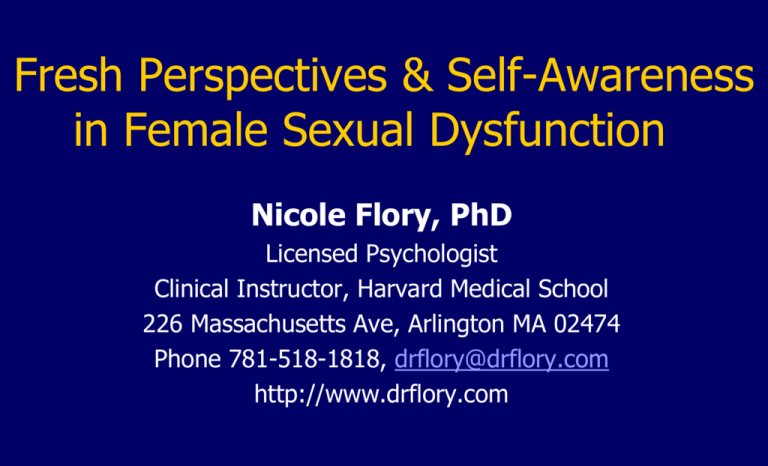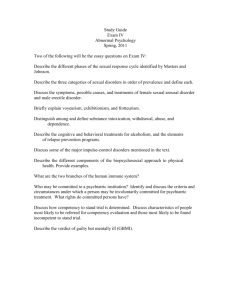
Fresh Perspectives & Self-Awareness
in Female Sexual Dysfunction
Nicole Flory, PhD
Licensed Psychologist
Clinical Instructor, Harvard Medical School
226 Massachusetts Ave, Arlington MA 02474
Phone 781-518-1818, drflory@drflory.com
http://www.drflory.com
Overview
•
•
•
•
•
Introduction
Definitions
Etiology
Treatments
Discussion
Introduction
• 43% of American women experience sexual
difficulties (Laumann et al., 1999)
~ 1/3 lack of interest in sex
~ 1/4 lack of orgasms
~ 1/5 lack of pleasure
Sexual & Genital Pain
• Experts report 1/3 of women experience
dyspareunia = pain during intercourse
(Glatt et al., 1990)
• 16 % of reproductive aged women
experience vulvodynia = chronic pain in the
vulvar region (Harlow et al., 2001)
Female Sexual Dysfunction = FSD
1.
2.
3.
4.
5.
6.
Hypoactive Sexual Desire Disorder
Sexual Aversion Disorder
Sexual Arousal Disorder
Orgasmic Disorder
Dyspareunia
Vaginismus
Definitions: Sexual Dysfunctions
1. Hypoactive Sexual Desire Disorder =
persistent or recurrent deficiency (or
absence) of sexual fantasies/ thoughts,
and/or desire for, or receptivity to, sexual
activity, which causes distress or
interpersonal difficulty
2. Sexual Aversion Disorder =
persistent or recurrent phobic aversion to
and avoidance of sexual contact with a
sexual partner, which causes distress or
interpersonal difficulty
3. Sexual Arousal Disorder =
persistent or recurrent inability to obtain or
maintain sufficient sexual excitement (may
be expressed by lack of subjective
excitement or genital response), which
causes distress or interpersonal difficulty
4. Orgasmic Disorder =
persistent or recurrent difficulty, delay in, or
absence of attaining orgasm following
sufficient sexual stimulation and arousal,
which causes distress or interpersonal
difficulty
Sexual Pain Disorders
5. Dyspareunia =
recurrent or persistent genital pain
associated with sexual intercourse, which
causes personal distress or interpersonal
difficulty
6. Vaginismus =
recurrent or persistent involuntary spasm of
the musculature of the vagina that
interferes with vaginal penetration, which
causes personal distress or interpersonal
difficulty
Biopsychosocial Model
• Multiple dimensions of sexual issues
should be addressed
• Integrative approach to maximize wellbeing works best
Etiology: Physical Factors
- Medications (antidepressants, birth control
pills, & some hypertension drugs)
- Hypothyroidism, hormonal deficiencies
- Nerve damage through diabetes,
hysterectomy, childbirth, atherosclerosis,
spinal cord injury
Medical Interventions
1. Blood testing should include general panel
& specific endocrine tests
2. Medications without sexual side-effects
should be explored
3. Reproductive issues should be discussed
4. Physical assessment should include specific
examination of the vulva, vagina, &
perineum
Psychosocial Factors
• Lack of knowledge about one’s body &
sexual response; unrealistic expectations
• Religious beliefs, social pressures
• History of sexual abuse, traumatic sexual &
medical experiences
• Fear of intimacy & losing control
Sexual Health Approach
• Accurate knowledge about sexuality,
personal awareness, & self-acceptance
• Sexual behavior should be congruent with
one’s values & self-definition
• Ability to choose when & how to have sex,
to communicate explicitly about sexuality &
to set appropriate boundaries
Cognitive Interventions
1. Educating about the female sexual
response cycle
2. Fostering assertiveness & self-control
3. Addressing negative thoughts (Self,
others, future)
“I rather have cancer”
“My husband won’t help”
“I will always be in pain”
Stress Management
• Stress related to performance anxiety,
infertility, raising children or balancing
professional & personal life
• Lack of quality time with the partner
relaxation training
increase of pleasurable activities
Relationship Issues
• Anger & resentment towards partner
• Sexual problems in partner
• Insensitive / unskilled partner can make
sex unrewarding
vicious cycle of rejection
Partner Interventions
1.
2.
3.
4.
5.
6.
Communication skills / active listening
Conflict resolution
Assertiveness
Scheduling of couple time
Discussion of sexual values, orientation
Sharing of sexual preferences & fantasies
Behavioral Interventions
1. Increasing physical activities / sleep
2. Practicing mind-body exercises:
- “Sensate focus” (Stage I, II, III, IV)
- Meditation / Mindfulness
- Hypnosis
3. Reading erotic literature (DISCUSSION)
4. Watching pornography (DISCUSSION)
5. Using sexual aids (DISCUSSION)
New Trends
• Mindfulness sign. improved women’s sexual
response & decreased distress (Brotto et
al., 2008)
• Pilot studies: acupuncture sign. improved
sexual desire (Brotto et al., 2008) &
reduced vulvodynia (Powell et al., 1999)
• Yoga increased female sexual function
(Dhikav et al., 2009)
Hypnotic Intervention
1.
2.
3.
4.
Relaxation
Sensory awareness / alteration
Cognitive restructuring
Ego-strengthening / trauma containment
“I am in a safe place”
“Connecting with sexual self”
“Connecting to core that is strong & confident”
Sexual Pain Disorders
- Medications, physical therapy, Kegels,
dilatation & transcutaneous nerve
stimulation
- Surgery & botox injections may be
considered, if all other treatments have
been unsuccessful
Evidence Based Treatments
• CBT effective (Bergeron et al., 2001)
• Hypnosis effective (Pukall et al., 2007)
Psychological pain management &
sex & couple’s therapy
Case Example:
Presenting Problems
•
•
•
•
•
Chronic pain in the vulva area
Pain during sexual intercourse
No intercourse for 6 yr
Pelvic floor dysfunction
0 desire for sexual intimacy
Vulvodynia
• ~16 % of reproductive aged women
• Pain in vulvar region lasting longer than 3
months (Harlow et al., 2001)
• Localized vs. Generalized
• Diagnosis of exclusion
• No visible pathology / lesions
• Most common cause for dyspareunia
Pain Assessment
• Location, intensity, frequency & quality of pain?
vulva vestibule (6 o’clock), 2-10, upon touch,
burning, raw
• When / how did it start?
7 yrs, shortly after marriage
• What makes it better?
Lidocaine, ice, physical therapy helpful
“Pain Channel”
•
•
•
•
•
Health problems (e.g. pelvic floor, urinary)
Loss of activity
Loss of pleasure
Relationship concerns
Negative thoughts, hopelessness
All pain is
felt in the
brain
VICIOUS CYLE OF PAIN
Sexual pain problems are affecting all aspects
of sexual experience:
- Decreased sexual interest
- Arousal
- Orgasmic response
- Sexual frequency
- Intimate relationship
DISCUSSION
• Sensate focus (Masters & Johnson, 1966)
vs. mindfulness (Brotto et al., 2008) vs.
hypnosis (Pukall et al., 2007)
Sensate Focus
•
•
•
•
•
•
(Re)discovering forms of touch
Paying attention to sensations
Awareness of own body / partner’s body
Open mind & body
No fear of failure
Feeling good in one’s skin
Pornography Debate
• Pornography supporters: Kinsey Institute
(founded 1947), Joe Cort (2011)
Pros
- Can increases sexual desire, fantasies,
arousal, orgasm, & frequency of sex
- Can create a “private world”, “private
vocabulary”
- Can facilitate numb discomfort; all in the
safety of own home
“I can get what I want when I want it”
Cons
-
Decreases couple time?
Ruins relationships?
Deadens erotic senses?
Akin to Adultery?
Sexist, exploitative?
Guilt, shame, anxiety, secrecy?
Out of control, addictive?
Pushing limits into illegal, risky behavior?





